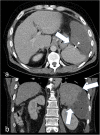Partial spleen embolization reduces the risk of portal hypertension-induced upper gastrointestinal bleeding in patients not eligible for TIPS implantation
- PMID: 28494001
- PMCID: PMC5426764
- DOI: 10.1371/journal.pone.0177401
Partial spleen embolization reduces the risk of portal hypertension-induced upper gastrointestinal bleeding in patients not eligible for TIPS implantation
Abstract
Introduction: Upper gastrointestinal bleeding (UGIB) is a severe and life-threatening complication among patients with portal hypertension (PH). Covered transjugular intrahepatic portosystemic shunt (TIPS) is the treatment of choice for patients with refractory or recurrent UGIB despite pharmacological and endoscopic therapy. In some patients, TIPS implantation is not possible due to co-morbidity or vascular disorders. Spleen embolization (SE) may be a promising alternative in this setting.
Materials and methods: We retrospectively analyzed 9 patients with PH-induced UGIB who underwent partial SE between 2012 and 2016. All patients met the following criteria: (i) upper gastrointestinal hemorrhage with primary or secondary failure of endoscopic interventions and (ii) TIPS implantation not possible. Each patient was followed for at least 6 months after embolization.
Results: Five patients (56%) suffered from cirrhotic PH, 4 patients (44%) from non-cirrhotic PH. UGIB occured in terms of refractory hemorrhage from gastric varices (3/9; 33%), hemorrhage from esophageal varices (3/9; 33%), and finally, hemorrhage from portal-hypertensive gastropathy (3/9; 33%). None of the patients treated with partial SE experienced re-bleeding episodes or required blood transfusions during a total follow-up time of 159 months, including both patients with cirrhotic- and non-cirrhotic PH.
Discussion: Partial SE, as a minimally invasive intervention with low procedure-associated complications, may be a valuable alternative for patients with recurrent PH-induced UGIB refractory to standard therapy.
Conflict of interest statement
Figures




Similar articles
-
Reduction in portal venous pressure by transjugular intrahepatic portosystemic shunt for treatment of hemorrhagic stomal varices.AJR Am J Roentgenol. 2014 Sep;203(3):668-73. doi: 10.2214/AJR.13.12211. AJR Am J Roentgenol. 2014. PMID: 25148174 Clinical Trial.
-
Transjugular Intrahepatic Portosystemic Shunt Creation and Variceal Coil or Plug Embolization Ineffectively Attain Gastric Variceal Decompression or Occlusion: Results of a 26-Patient Retrospective Study.J Vasc Interv Radiol. 2016 Jul;27(7):1001-11. doi: 10.1016/j.jvir.2016.02.019. Epub 2016 Apr 19. J Vasc Interv Radiol. 2016. PMID: 27106732
-
Partial splenic embolization as a rescue and emergency treatment for portal hypertension and gastroesophageal variceal hemorrhage.BMC Gastroenterol. 2023 May 24;23(1):180. doi: 10.1186/s12876-023-02808-1. BMC Gastroenterol. 2023. PMID: 37226088 Free PMC article.
-
The role of transjugular intrahepatic portosystemic shunt (TIPS) in the management of portal hypertension.J Clin Gastroenterol. 2007 Nov-Dec;41 Suppl 3:S344-51. doi: 10.1097/MCG.0b013e318157e500. J Clin Gastroenterol. 2007. PMID: 17975487 Review.
-
Transjugular intrahepatic portosystemic shunts and portal hypertension-related complications.World J Gastroenterol. 2014 Dec 7;20(45):16996-7010. doi: 10.3748/wjg.v20.i45.16996. World J Gastroenterol. 2014. PMID: 25493012 Free PMC article. Review.
Cited by
-
The Impact of Partial Splenic Embolization on Portal Hypertensive Gastropathy in Cirrhotic Patients with Portal Hypertension.J Clin Med. 2023 Apr 3;12(7):2662. doi: 10.3390/jcm12072662. J Clin Med. 2023. PMID: 37048744 Free PMC article.
-
Splenic artery embolization for variceal bleeding in portal hypertension: a systematic review and metanalysis.Emerg Radiol. 2025 Feb;32(1):79-95. doi: 10.1007/s10140-024-02299-x. Epub 2024 Nov 22. Emerg Radiol. 2025. PMID: 39576386
-
Short-term Effects of Hepatic Arterial Buffer Responses Induced by Partial Splenic Embolization on the Hepatic Function of Patients with Cirrhosis According to the Child-Pugh Classification.Intern Med. 2021 May 1;60(9):1331-1342. doi: 10.2169/internalmedicine.6267-20. Epub 2020 Dec 7. Intern Med. 2021. PMID: 33281164 Free PMC article.
-
Observation of immediate and mid-term effects of partial spleen embolization in reducing hepatic venous pressure gradient.Medicine (Baltimore). 2019 Nov;98(47):e17900. doi: 10.1097/MD.0000000000017900. Medicine (Baltimore). 2019. PMID: 31764786 Free PMC article.
-
Clinical Feasibility of Large Gastrotomy Closure Using a Flexible Tissue Glue Based on N-Butyl-2-Cyanoacrylate: Experimental Study in Pigs.J Gastrointest Surg. 2019 Feb;23(2):247-255. doi: 10.1007/s11605-018-3910-y. Epub 2018 Aug 10. J Gastrointest Surg. 2019. PMID: 30097967
References
-
- Yang S-C, Wu K-L, Wang J-H, Lee C-H, Kuo Y-H, Tai W-C, et al. The effect of systemic antibiotic prophylaxis for cirrhotic patients with peptic ulcer bleeding after endoscopic interventions. Hepatol Int. 2013;7: 257–267. doi: 10.1007/s12072-012-9378-z - DOI - PubMed
-
- de Franchis R, Baveno VI Faculty. Expanding consensus in portal hypertension: Report of the Baveno VI Consensus Workshop: Stratifying risk and individualizing care for portal hypertension. J Hepatol. 2015;63: 743–752. doi: 10.1016/j.jhep.2015.05.022 - DOI - PubMed
-
- Parker R. Role of transjugular intrahepatic portosystemic shunt in the management of portal hypertension. Clin Liver Dis. 2014;18: 319–334. doi: 10.1016/j.cld.2013.12.004 - DOI - PubMed
MeSH terms
LinkOut - more resources
Full Text Sources
Other Literature Sources
Medical
Miscellaneous

